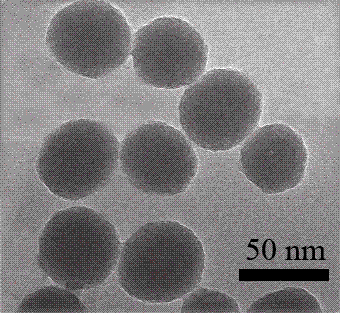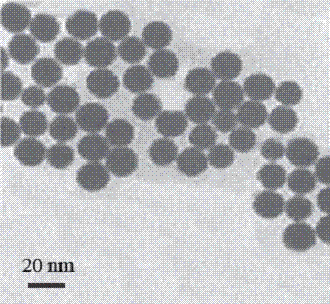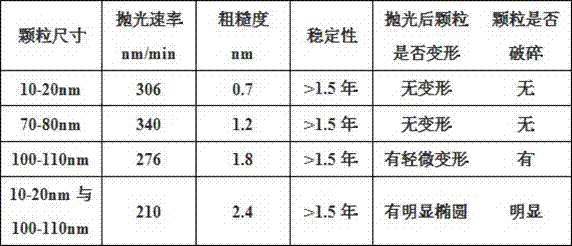Polishing silica sol for LED sapphire substrates and preparation method thereof
A sapphire substrate and silicon polishing technology, which is applied in the direction of polishing compositions containing abrasives, can solve the problems of large particle size, breeding of bacteria and fungi, and product scrapping, and achieve uniform particle size, no deformation of particle size, The effect of high hydroxyl utilization rate
- Summary
- Abstract
- Description
- Claims
- Application Information
AI Technical Summary
Problems solved by technology
Method used
Image
Examples
Embodiment 1
[0037] A kind of polishing silica sol for LED sapphire substrate, described silica sol comprises:
[0038] Silicon oxide source: ethyl orthosilicate, 5wt.%;
[0039] Surfactant: polyethylene glycol monooctyl phenyl ether, 1wt.%;
[0040] Co-surfactant: 4-methyl-2-pentanol, 1wt.%;
[0041] Organic solvent: cyclohexane, 5wt.%;
[0042] pH regulator: Potassium tert-butoxide;
[0043] Metal ion chelating agent: ethylenediaminetetraacetic acid, 3wt.%;
[0044] The balance is deionized water.
[0045]A preparation method of polished silica sol for LED sapphire substrates, the steps are as follows: first add polyethylene glycol monooctylphenyl ether surfactant, 4-methyl-2-pentanol auxiliary Mix surfactant and cyclohexane organic solvent, stir magnetically for 10-20min at room temperature, add a certain amount of deionized water, continue magnetically stirring for 30-40min to obtain a uniform and stable W / O emulsion, and then pour into the emulsion in turn Add ethylenediamine te...
Embodiment 2
[0048] A kind of polishing silica sol for LED sapphire substrate, described silica sol comprises:
[0049] Silicon oxide source: ethyl orthosilicate, 20wt.%;
[0050] Surfactant: polyethylene glycol monooctyl phenyl ether;
[0051] Co-surfactant: 4-methyl-2-pentanol, 1.25wt.%;
[0052] Organic solvent: cyclohexane, 5wt.%;
[0053] PH regulator: Potassium tert-butoxide;
[0054] Metal ion chelating agent: ethylenediaminetetraacetic acid, 4wt.%;
[0055] The balance is deionized water, wherein the molar ratio of deionized water / polyethylene glycol monooctylphenyl ether is 23, the size of the silicon oxide particles obtained is between 10-20nm, the pH value is 12.0, and the polishing rate is 306nm / min, stability greater than 1.5 years, milky white, roughness 0.7nm, specific gravity 1.17~1.19g / cm 2 , viscosity 7.8mm 2 / s.
Embodiment 3
[0057] A kind of polishing silica sol for LED sapphire substrate, described silica sol comprises:
[0058] Silicon oxide source: ethyl orthosilicate, 40wt.%;
[0059] Surfactant: polyethylene glycol monooctyl phenyl ether, 15wt.%;
[0060] Co-surfactant: 4-methyl-2-pentanol, 1.5wt.%;
[0061] Organic solvent: cyclohexane, 7wt.%;
[0062] pH regulator: Potassium tert-butoxide;
[0063] Metal ion chelating agent: ethylenediaminetetraacetic acid, 5wt.%;
[0064] The balance is deionized water.
PUM
| Property | Measurement | Unit |
|---|---|---|
| size | aaaaa | aaaaa |
| size | aaaaa | aaaaa |
| surface roughness | aaaaa | aaaaa |
Abstract
Description
Claims
Application Information
 Login to View More
Login to View More - R&D
- Intellectual Property
- Life Sciences
- Materials
- Tech Scout
- Unparalleled Data Quality
- Higher Quality Content
- 60% Fewer Hallucinations
Browse by: Latest US Patents, China's latest patents, Technical Efficacy Thesaurus, Application Domain, Technology Topic, Popular Technical Reports.
© 2025 PatSnap. All rights reserved.Legal|Privacy policy|Modern Slavery Act Transparency Statement|Sitemap|About US| Contact US: help@patsnap.com



